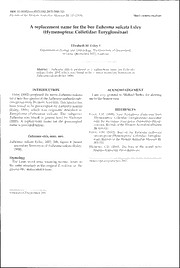
A replacement name for the bee Euhesma sulcata Exley (Hymenoptera: Colletidae: Euryglossinae) PDF
Preview A replacement name for the bee Euhesma sulcata Exley (Hymenoptera: Colletidae: Euryglossinae)
DOI: 10.18195/issn.0312-3162.24(2).2008.215 Records of the Western Australian Museum 24: 215 (2008). Short communication A replacement name for the bee Euhesma sulcata Exley (Hymenoptera: Colletidae: Euryglossinae) Elizabeth M. Exley t Department of Zoology and Entomology, 1 lie University of Queensland, St Lucia, Queensland 4072, Australia Abstract . Euhesma stria is proposed as a replacement name for Euhesma sulcata Exley 2002 which was found to be a junior secondary homonym of Euhesma sulcata (Exley 1998). INTRODUCTION ACKNOWLEDGEMENT Exley (2002) proposed the name Euhesma sulcata I am very grateful to Michael Bat ley for alerting for a new bee species of the Euhesma crabonica spe¬ me to the homonymv. cies-group from Western Australia. This species has been found to be preoccupied by Euhesma sulcata (Exley, 1998), which was originally described as REFERENCES EurygJossa (Euhesma) sulcata. The subgenus Exley, E.M. (1998). New Euryglossa (Euhesma) bees Euhesma was raised to generic level by Michener (Hymenoptera: Colletidae: Euryglossinae) associated (2000). A replacement name for the preoccupied with the Australian plant genus Eremophila (Myop- name is provided below. oraeeae). Records of the Western Australian Museum 18: 419-437. Exlev, E.M. (2002). Bees of the Euhesma crabonica Euhesma stria, nom. nov. species-group (Hymenoptera: Colletidae: Eurygloss¬ inae). Records of the Western Australian Museum 21: Euhesma sulcata Exley, 2002: 208, figure 4. Junior 203-211. secondary homonym of Euhesma sulcata (Exley, Michener, C.D. (2000). The bees of the world. John 1998). Hopkins University Press: Baltimore. Etymology The Latin word stria, meaning furrow, refers to Manuscript accepted 6 July 2007. the same structure as the original E. sulcata, i.e. the groove-like metasomal foveae. t Deceased 2 September 2007
